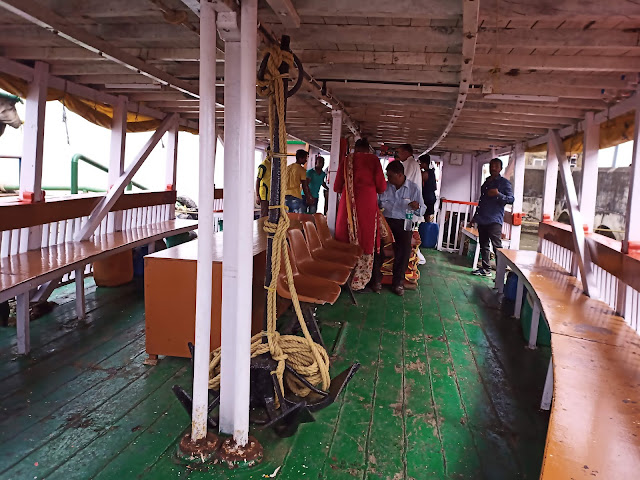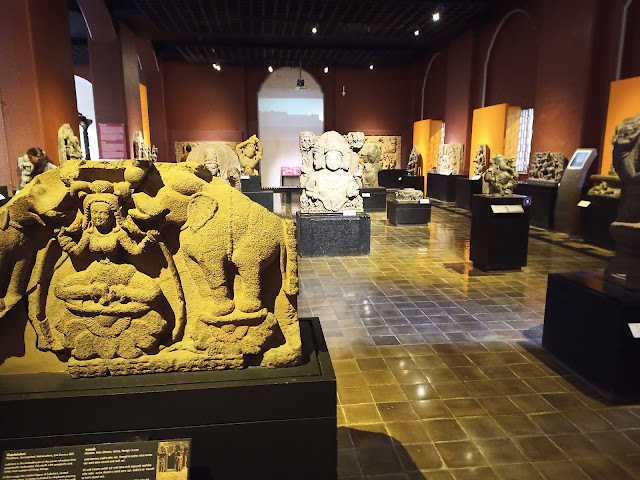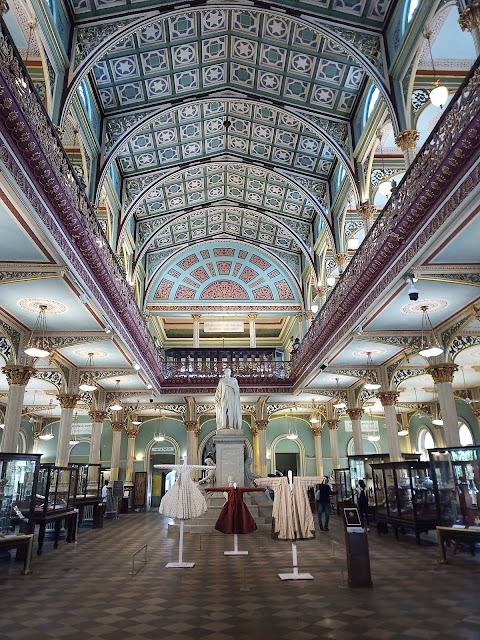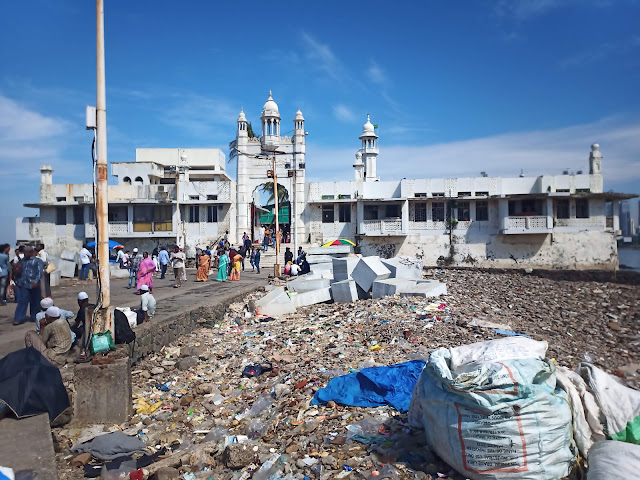An Archaeologist's Guide to Maharashtra, India: Mumbai
The last stop on my tour of India is Mumbai, the most heavily populated city in the country. My journey there from Pune was in the sleeper car of a train and took about three to four hours. The Chennai Ltt Express (11074) as it is known travels from Chennai Central station in the southeast of the country for over 24 hours until it reaches Lokmanyatilak station on the west coast in Mumbai. As a result, there was an extremely varied assortment of people on the train from all areas of India.
Mumbai historically consisted of seven different islands that were occupied by Marathi speaking communities. The land was relinquished to the Portuguese Empire, one of the longest continuous colonial empires (spanning about 600 years until the late 20th century), and then to the East India Company in 1661. The East India Company was established by the British in 1600 to trade in the Indian Ocean area, and played a significant role in the colonisation and oppression of local people and cultures throughout Asia.
In the mid-18th century the seven islands of Mumbai were combined in the Hornby Vellard project, which involved building causeways connecting the islands into one through construction of major roads and railways, and the reclamation of large areas of land to prevent low altitude regions of the city being flooded at high tide. This resulted in the city that you see today when visiting Mumbai, which has a rich archaeological history.
During the colonial period the city name was anglicised as Bombay. The name of the city was officially changed to the Marathi name Mumbai in 1995 by the Government of India to assert the cultural heritage of the country and move beyond the colonial past.
The island was named by the Portuguese in the 16th century who found a large basalt elephant sculpture near the front entrance. As with most nice things, the colonialists removed it to take back home and, while trying to get it back to the mainland, dropped it in the sea.
Upon arriving at the island, visitors have the choice of either walking down the narrow strip of land to the base of the steps leading up to the Elephanta Caves, or taking the toy train along this route for 10 rupees (about 0.15 USD or 0.20 AUD). I opted to try the train on the way into the island, and later walked back to the jetty. It turned out the train doesn't actually take you very far, but it was a fun ride nonetheless.
At the island end of the train track there is a significant series of somewhat steep steps reaching up to the main archaeological site. As a result, the site is unfortunately not accessible to those with mobility restrictions. At the base of the stairs visitors are required to purchase a ticket for 5 rupees to enter the 'Village Panchayt Gharapuri (Elephanta)' which lays beyond. After this checkpoint, on both sides of the staircases and paths leading up are stalls selling food, drink and many other wares. The prices for the souvenirs and other items were surprisingly quite cheap, particularly in comparison to other markets that I visited during my trip. The blue tarpaulin over the market stalls bathes everything in an unusual blue glow.
At the top of the final staircase is the ticket booth for the Elephanta Caves, which were the reason for my visit. The ticket for foreigners is 600 rupees (about 8.50 USD or 12 AUD) and gives access to the whole site. After this extended journey, I was finally at my destination. The Elephanta Caves are an incredible monument carved from rock sometime during the 5th-6th century CE, and are inscribed on the World Heritage List.
The site consists of a number of caves, the largest and most impressive closest to the entrance (Cave 1). Rock cut figures of Shiva and other Hindu deities decorate the walls of the cave, and small devotional shrines are present throughout. Many of the stone figures are damaged, but this does not detract from their sheer scale.


Various historical buildings and temples surround the tank, and it is a cultural hub and source of inspiration for many artists and visitors to Mumbai.
The legend behind the origins of the tank is that Lord Rama, the hero in the Sanskrit epic story the Ramayana, was searching for his wife and became extremely tired and thirsty. His brother Lakshmana shot an arrow into the ground, and from this spot water emerged to create a tributary flow from the Ganges river. The tank received its name from this story, with Banganga meaning the Ganga (river) that was created by baan (an arrow).
Tweet
Mumbai historically consisted of seven different islands that were occupied by Marathi speaking communities. The land was relinquished to the Portuguese Empire, one of the longest continuous colonial empires (spanning about 600 years until the late 20th century), and then to the East India Company in 1661. The East India Company was established by the British in 1600 to trade in the Indian Ocean area, and played a significant role in the colonisation and oppression of local people and cultures throughout Asia.
In the mid-18th century the seven islands of Mumbai were combined in the Hornby Vellard project, which involved building causeways connecting the islands into one through construction of major roads and railways, and the reclamation of large areas of land to prevent low altitude regions of the city being flooded at high tide. This resulted in the city that you see today when visiting Mumbai, which has a rich archaeological history.
During the colonial period the city name was anglicised as Bombay. The name of the city was officially changed to the Marathi name Mumbai in 1995 by the Government of India to assert the cultural heritage of the country and move beyond the colonial past.
Gateway of India
The Gateway of India was built in 1924 as a monument to the landing of the King-Emperor George V and Queen-Empress Mary in 1911 at the port in this location, marking the first visit of a British monarch to India. Although clearly a symbol of colonial rule, the architecture of the gateway includes some early modern Marathi elements in the Indo-Saracenic style (a combination of Indian and European Gothic).
The gateway is a popular tourist destination and as a result is filled with locals trying to make some money by offering to take photographs of visitors with the monument. One keen photographer let me know that he had a high quality Samsung phone and would send me the digital copies of the photographs he had taken. I politely declined.
The main reason that I visited the Gateway of India was that I was planning to take a boat from the still operational port behind the gateway to Elephanta Island, also known as Gharapuri. Ferry tickets can be purchased from the ticket counters near the gateway, and cost 205 rupees (about 3 USD or 4 AUD) for a return trip.
Elephanta Caves
The journey between the Gateway of India and Elephanta Island takes about one hour in each direction. Snacks and drinks are sold on the ferry, and visitors can take in a nice view of the Mumbai shoreline from the Arabian Sea.The island was named by the Portuguese in the 16th century who found a large basalt elephant sculpture near the front entrance. As with most nice things, the colonialists removed it to take back home and, while trying to get it back to the mainland, dropped it in the sea.
Upon arriving at the island, visitors have the choice of either walking down the narrow strip of land to the base of the steps leading up to the Elephanta Caves, or taking the toy train along this route for 10 rupees (about 0.15 USD or 0.20 AUD). I opted to try the train on the way into the island, and later walked back to the jetty. It turned out the train doesn't actually take you very far, but it was a fun ride nonetheless.
At the island end of the train track there is a significant series of somewhat steep steps reaching up to the main archaeological site. As a result, the site is unfortunately not accessible to those with mobility restrictions. At the base of the stairs visitors are required to purchase a ticket for 5 rupees to enter the 'Village Panchayt Gharapuri (Elephanta)' which lays beyond. After this checkpoint, on both sides of the staircases and paths leading up are stalls selling food, drink and many other wares. The prices for the souvenirs and other items were surprisingly quite cheap, particularly in comparison to other markets that I visited during my trip. The blue tarpaulin over the market stalls bathes everything in an unusual blue glow.
At the top of the final staircase is the ticket booth for the Elephanta Caves, which were the reason for my visit. The ticket for foreigners is 600 rupees (about 8.50 USD or 12 AUD) and gives access to the whole site. After this extended journey, I was finally at my destination. The Elephanta Caves are an incredible monument carved from rock sometime during the 5th-6th century CE, and are inscribed on the World Heritage List.
The site consists of a number of caves, the largest and most impressive closest to the entrance (Cave 1). Rock cut figures of Shiva and other Hindu deities decorate the walls of the cave, and small devotional shrines are present throughout. Many of the stone figures are damaged, but this does not detract from their sheer scale.


The other four caves are smaller than the first one and more damaged, but are still intricately carved into the rock face with pillars and arches throughout. Small monkeys play outside the caves, running along the pathways and eating fruit.
The final cave (Cave 5) is unfinished, heavily damaged, and closed to visitors. From Cave 5 visitors need to turn back and walk along the path again to the entrance in order to leave the site. There are also a number of smaller stupas (commemorative Buddhist monuments) dotted around the hillside.
The final cave (Cave 5) is unfinished, heavily damaged, and closed to visitors. From Cave 5 visitors need to turn back and walk along the path again to the entrance in order to leave the site. There are also a number of smaller stupas (commemorative Buddhist monuments) dotted around the hillside.
I found the caves very impressive, and visitors can easily spend about an hour here looking at the intricacies of each of the structures.
Chhatrapati Shivaji Maharaj Vastu Sangrahalaya (Museum)
This lengthily titled museum, also known as King Shivaji Museum or CSMVS (named after the founder of the Marathi empire), was established in the early 20th century by the citizens of Mumbai. Again, this building is constructed in the Indo-Saracenic architectural style. As the city's main museum, the CSMVS covers all things India, ranging from the ancient Indus Valley Civilisation through to various Indian empires including the Mauryans (322-185 BCE) and the Guptas (mid 3rd century CE to 543 CE). The museum also has a significant natural history collection and art from across the subcontinent, Asia and Europe.
The museum is open daily and entry costs 650 rupees for foreigners (about 9 USD or 13 AUD). It was only after entering the museum that I realised that I had received the adult Indian price (100 rupees) for my ticket as I had purchased it in Hindi (I think my brown skin also had something to do with it).
Feeling pleased with myself, I spent a few hours exploring the museum. The quality and number of galleries make this museum a good way to spend a couple of hours. The stone sculptures gallery in particular was one of my favourites.
Dr Bhau Daji Lad Mumbai City Museum
Another of the well-known museums in Mumbai is the Dr Bhau Daji Lad Mumbai City Museum, located in the grounds of the Byculla Zoo. The museum was named after a prominent Indian physician who practiced in the 19th century and studied Indian archaeological and historical artefacts. This is the oldest museum in Mumbai, dating from 1855, and was originally named the Victoria and Albert Museum (like the one in London), created as a large gallery displaying decorative and industrial arts in India.
Outside the museum is an important artefact that will be familiar to readers. To the right of the museum building is the elephant basalt sculpture from Elephanta Island. Yes, this is the sculpture that the Portuguese dropped in the sea. The sculpture was eventually recovered from the sea, reconstructed and placed in these gardens.
The museum's collections include many archaeological artefacts, maps and historical photos of Mumbai, as well as ceramics, silver and copper objects, and textiles and costumes. This serves as a great display of the breadth and depth of art throughout the history of the Indian subcontinent, and in Mumbai in particular. The interior decoration of the museum building itself is also very beautiful.
The city museum is open daily, except for Wednesdays, and costs foreigners 100 rupees for entry (about 1.50 USD or 2 AUD).
Haji Ali Dargah
The Haji Ali Dargah is a mosque and tomb (dargah) located at the end of a long narrow strip of land in the southwest of Mumbai. It can only be reached by foot traffic and was built in 1431 to commemorate its namesake, a saint of Sufism (Islamic mysticism) who donated all his possessions and travelled to Mecca. The causeway that connects the mainland to the mosque can become inaccessible during high tide or flooding.
The white marble structure has an impressive facade, although this is somewhat diminished by the large quantity of rubbish washed up from the sea surrounding both sides of the causeway. Inside, there is a main forecourt that is accessible to all, and also separate areas for men and women to pray.
Due to the salinity of its location within the Arabian Sea, the structure is constantly eroding and requires frequent upkeep. During my visit there was clearly some construction work taking place, and the inside of the mosque was full of scaffolding.
I would imagine that the mosque and tomb structure would have been much more impressive soon after its initial construction, when the marble would have gleamed in the sun and the interior was intact. Regardless of this, the position of the mosque in the water, surrounded by sea on all sides, is quite a spectacular scene.
From the rear of the mosque there is a view into the Arabian Sea as well as of the Mumbai skyline.
Baganga Tank
Located close to the southwest tip of Mumbai in the Malabar Hill area is the Baganga Tank, a water tank constructed in 1127 CE. The tank was later rebuilt in 1715 CE through funding from a donation for a nearby Hindu temple. The tank is still standing today, and its surrounding steps provide a meeting place for locals and temple goers.
To reach the tank visitors follow a downward sloping path that weaves past small temples and the homes of locals.
Various historical buildings and temples surround the tank, and it is a cultural hub and source of inspiration for many artists and visitors to Mumbai.
The legend behind the origins of the tank is that Lord Rama, the hero in the Sanskrit epic story the Ramayana, was searching for his wife and became extremely tired and thirsty. His brother Lakshmana shot an arrow into the ground, and from this spot water emerged to create a tributary flow from the Ganges river. The tank received its name from this story, with Banganga meaning the Ganga (river) that was created by baan (an arrow).
In Summary
Mumbai is an enormous city with a rich cultural history and much to see. The ornately carved Elephanta Caves were a highlight for me. I also really enjoyed the two museums that I have mentioned, which are very artfully curated and educate visitors on the long history of the subcontinent.
Anyone visiting Mumbai should also be sure to take a walk along the sea at the Queen's Necklace on Marine Drive in the evening, when the lights of the city sparkle and reflect onto the water by the beach.
Anyone visiting Mumbai should also be sure to take a walk along the sea at the Queen's Necklace on Marine Drive in the evening, when the lights of the city sparkle and reflect onto the water by the beach.
Tweet


























Love the names of these places. I especially like the story behind the Baanganga and the name would really like to visit that museum sometime.
ReplyDelete